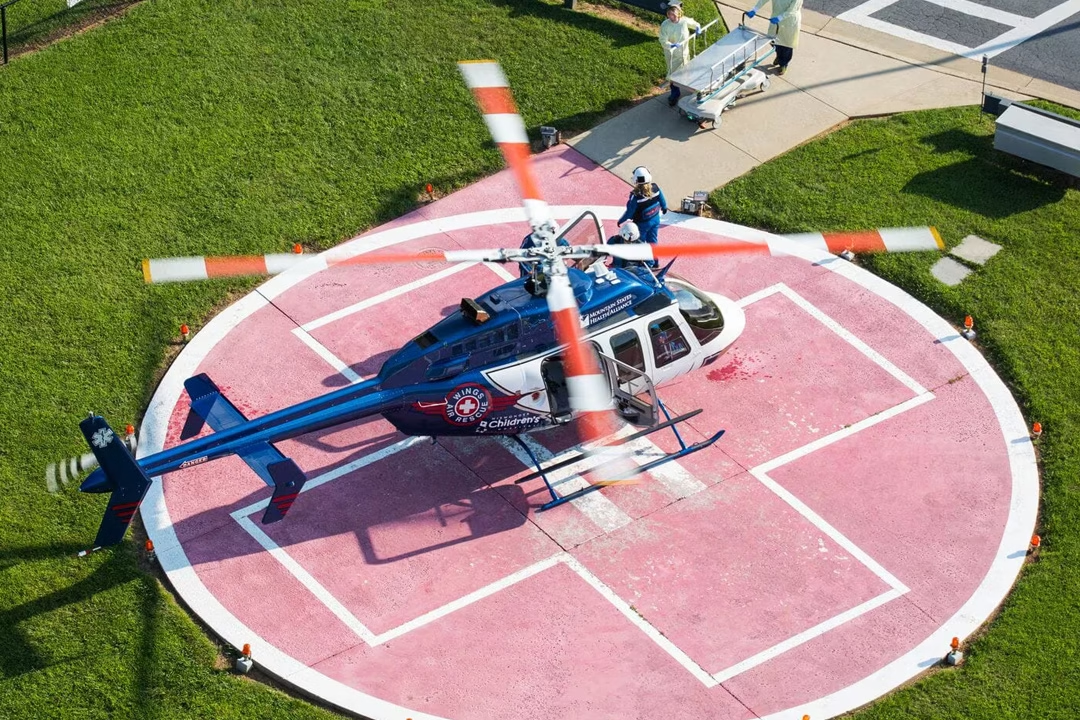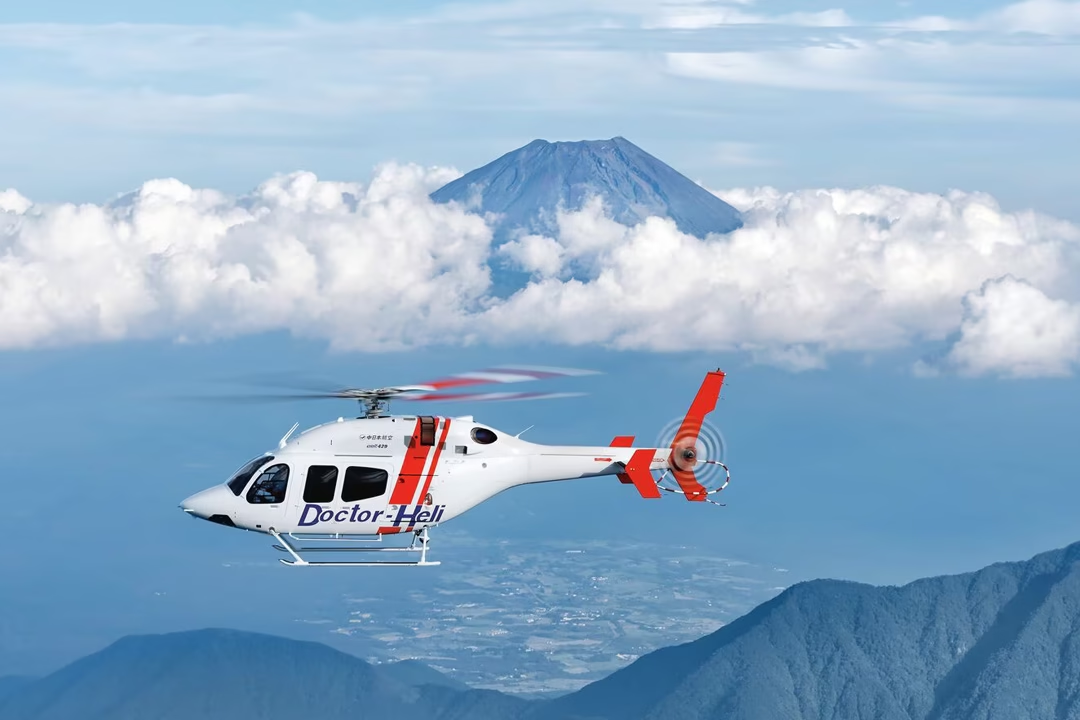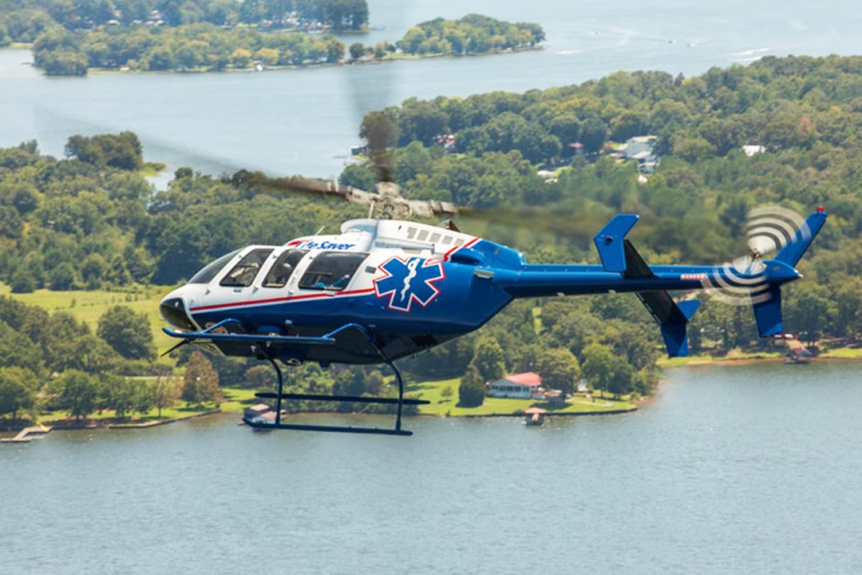Air Methods is enhancing its lifesaving capabilities with a significant air ambulance fleet expansion, introducing advanced Bell 407GXi and Bell 429 helicopters. These aircraft feature modern avionics, larger mission ready cabins, and performance upgrades that directly bolster a network serving nearly 100,000 patients annually.
Saving Critical Time for Patients Through Fleet Expansion
Faster launch times, better dispatch reliability, and wider reach save crucial time between incident and definitive care. Air Methods operates from about 300 bases across 47 to 48 states and flies over 150,000 hours annually, so incremental gains in performance and uptime scale into thousands of minutes saved for trauma, cardiac, and stroke patients.
The Bell 407GXi: A Versatile Workhorse for HEMS

A Bell 407GXi lands at a hospital helipad. | Photo: bellflight.com
The Bell 407GXi is a single engine workhorse tailored for Helicopter Emergency Medical Services with IFR capability, efficient operating costs, and a footprint that suits rooftop pads and tight rural scenes. Its integrated Garmin G1000H NXi flight deck improves situational awareness with synthetic vision and streamlined navigation management that reduce pilot workload in complex weather and night operations.
- IFR readiness supports launches in marginal conditions that might otherwise delay transport.
- Cabin flexibility accommodates litters, ventilators, pumps, and monitoring with efficient loading and clinical access.
- Proven reliability paired with health monitoring options that support higher availability and proactive maintenance.
Enabling In Flight Critical Care with the Bell 429

A Bell 429 descends for a remote location pick-up. | Photo: bellfilight.com
The Bell 429 adds twin engine redundancy, a larger flat floor cabin, and clamshell rear doors that simplify patient loading. The latest delivery into the Air Methods fleet strengthens long range transfers, neonatal and specialty care, and missions where extra space and systems redundancy improve clinical workflow and safety margins.
- BasixPro cockpit with large displays and satellite navigation improves crew coordination and flight path management.
- Rear clamshell doors speed time to cabin and create space for trauma team positioning around the patient.
A Phased Approach to National Growth
Air Methods signed a Master Purchasing Agreement that enables up to 27 aircraft, including fifteen IFR configured Bell 407GXi with options for additional units and a Bell 429 already accepted into service.
The staged cadence lets the operator refresh older airframes, densify coverage where demand is rising, and assign aircraft types to mission profiles that maximize clinical benefit and utilization.
Technology that lifts availability and safety

The Doctor-Heli Bell 429 Helicopter | Photo: bellflight.com
Modern avionics matter in HEMS. The G1000H NXi suite on the 407GXi integrates synthetic vision, traffic, terrain, and streamlined comms so pilots can maintain precision and workload balance in low visibility, IMC, and night environments.
Health and Usage Monitoring Systems further support uptime. A relevant benchmark in the HEMS community is the GPMS Foresight MX installation on a Bell 407GXi at HALO Flight in Texas, which enables early fault detection, trend tracking, and smarter maintenance planning that keeps aircraft mission ready more days of the year.
Key facts that shape the next phase

CareFlite’s Bell 407 | Photo: bellflight.com
- Three additional Bell 407GXi helicopters signed for the fleet, with a recent Bell 429 delivery already in place.
- Master Purchasing Agreement enables up to 27 aircraft as demand and operating needs evolve across the network.
- System scale supports more than 100,000 patient transports each year with a national base footprint that reduces response distances.
What this means for hospitals, EMS, and communities
Hospitals can rely on shorter out of hospital intervals for transfers into trauma, cardiac, stroke, and neonatal centers. EMS agencies gain a more predictable launch profile and a closer match between aircraft and mission type.
Communities in rural and medically underserved regions see stronger backfill for ground transport gaps as the air ambulance fleet expansion rolls into service areas.
A Strategic Investment in the Future of Emergency Care

Classic Air Medical’s Bell 407 | Photo: bellflight.com
This phased fleet expansion is more than just adding new helicopters; it is a strategic upgrade to the very infrastructure of emergency response. By integrating the versatile Bell 407GXi and the advanced Bell 429, Air Methods is not only addressing today’s needs but also building a more resilient, responsive, and capable network for the future.
The focus on modern avionics, enhanced safety, and mission-specific design translates directly into a higher standard of care from the scene to the hospital door. For the nearly 100,000 patients served each year, this investment means that in their most critical moments, time and technology are increasingly on their side.
